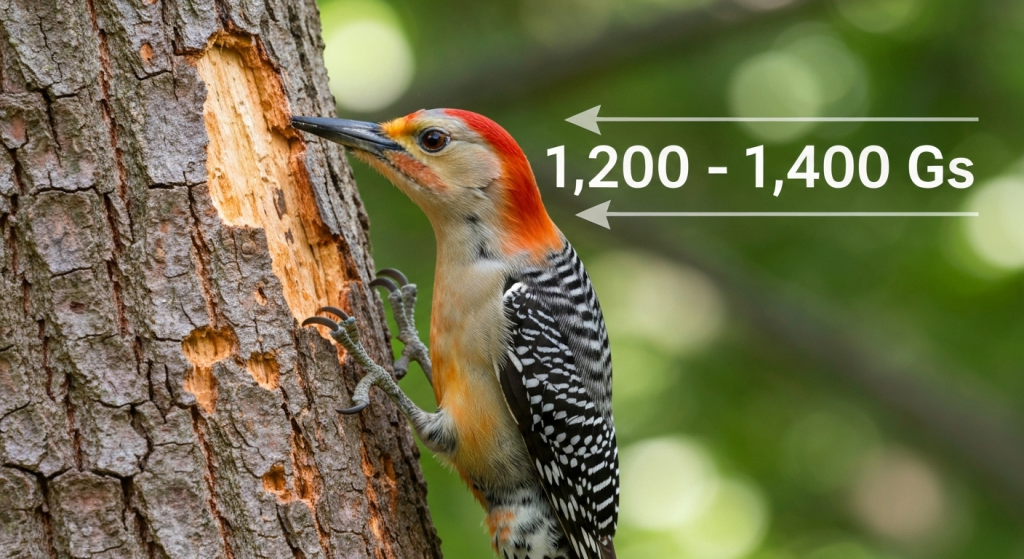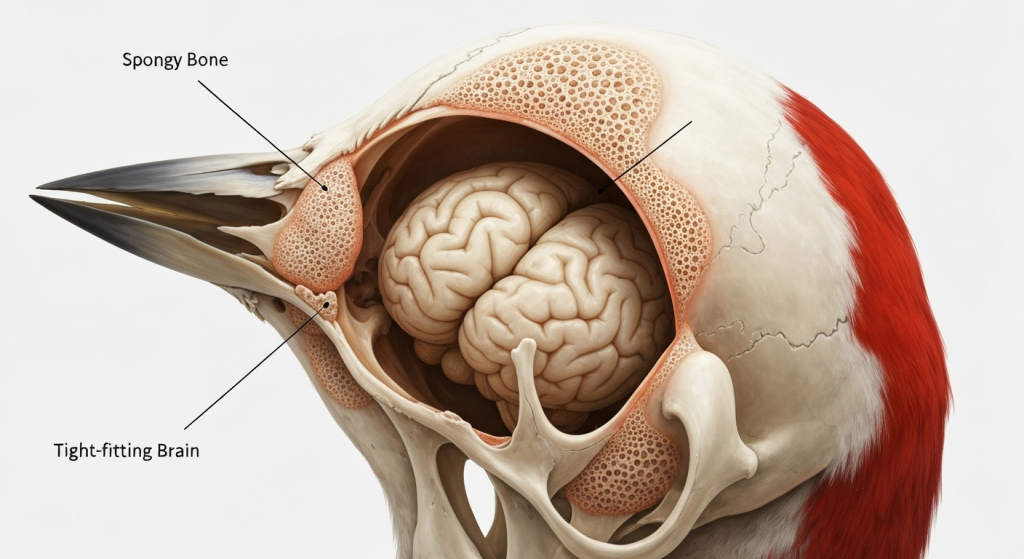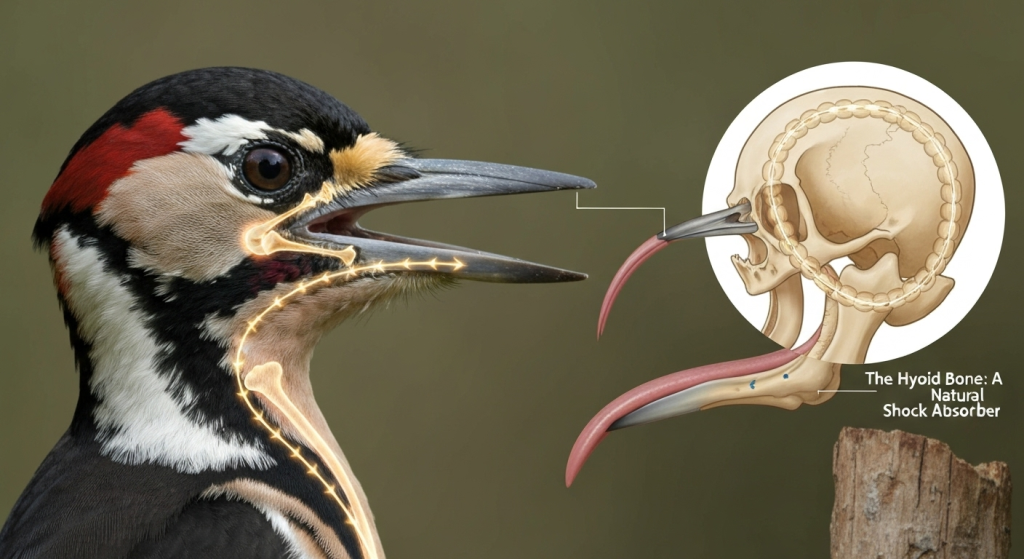Have you ever stopped to watch a woodpecker at work? It’s an incredible display of power and persistence. The bird anchors itself to a tree trunk and hammers its beak against the wood with a speed that’s almost too fast to see. They do this thousands of times every single day. This simple observation leads to a fascinating question: How can a bird slam its head into a hard surface repeatedly without causing severe brain damage? The forces involved are immense, far greater than what a human could ever withstand.
The answer isn’t a single trick; it’s a masterpiece of evolutionary engineering. Woodpeckers are equipped with a complex, built-in safety system that protects their brains from the constant, high-speed impacts. From a specialized skull to a tongue that acts like a safety harness, every part of their head is designed for this unique and demanding lifestyle. Understanding these features gives us a deeper appreciation for the incredible adaptations found in the natural world.
For the past five years, my work has involved exploring and explaining the wonders of the avian world. My name is Mahnoor Farooq, and this journey has taken me from observing common backyard birds to researching the unique biological mechanics of species like the woodpecker. This passion for understanding how and why birds do what they do drives my writing. The woodpecker’s ability to withstand these forces isn’t just a fun fact; it’s a brilliant case study in natural design that I’ve been fascinated with for years. Let’s break down the science behind this amazing feat.
The Shocking Force of a Woodpecker’s Peck

To truly appreciate a woodpecker’s protective gear, we first need to understand the incredible forces it endures. Scientists measure impact force in G-force, where 1 G is the force of gravity we experience every day. The numbers associated with woodpecker drilling are staggering.
Here’s the thing: with every single peck, a woodpecker’s head experiences a deceleration of about 1,200 to 1,400 Gs. To put that into perspective, a human fighter pilot might experience around 9 Gs during a high-speed turn and can lose consciousness. A car crash at 25 mph can generate around 100 Gs, an impact that would be catastrophic and likely fatal for a person. The woodpecker endures more than ten times that force, up to 20 times per second. This consistent, powerful impact would turn a human brain to pulp, yet the woodpecker flies away completely unharmed.
| Subject | G-Force Experienced | Outcome |
| Human | 50-100 Gs | Severe injury or fatality |
| Fighter Pilot | 9-12 Gs | Can lead to loss of consciousness |
| Woodpecker | 1,200-1,400 Gs | Experiences no apparent injury |
This level of force tolerance is what makes the woodpecker a subject of intense study. It has evolved a suite of solutions to a problem that would otherwise make its way of life impossible.
A Skull Built for Impact

The first line of defense is the woodpecker’s skull itself, which is anything but ordinary. It’s a dense, yet surprisingly light structure that is specially adapted to absorb and redirect the shock of each peck. It’s not just one feature but a combination of several working together that makes this possible.
The Spongy Bone Shock Absorber
One of the most critical adaptations is the presence of spongy bone in specific areas of the skull. Located primarily in the front and back of the cranium, this bone isn’t solid like the rest of the skull. Instead, it has a mesh-like, porous structure filled with trabeculae—tiny beams of bone.
Think of it like a piece of high-tech Styrofoam or a very dense sponge. When the woodpecker strikes the tree, the force travels from the beak toward the braincase. Before it can reach the brain, it hits this spongy bone. The porous structure compresses slightly, absorbing the kinetic energy and distributing it over a wider area. This action dampens the vibration significantly, much like how a shock absorber on a car smooths out bumps in the road. This prevents the full force of the impact from being transferred directly to the brain.
A Snug Fit: The Brain’s Advantage
A woodpecker’s brain is not only small but also fits very tightly inside its skull. There is very little cerebrospinal fluid (CSF) surrounding it. In humans, a concussion often occurs when the head stops suddenly, but the brain continues to move, sloshing in the CSF and colliding with the inside of the skull. This is known as a contrecoup injury.
The woodpecker’s brain, however, has almost no room to move. It’s packed in so snugly that the damaging sloshing motion is prevented. Furthermore, the brain is oriented in a way that maximizes the surface area in contact with the skull, which helps to spread out any impact force that does get through. This combination of a tight fit and broad contact area is a simple but highly effective way to keep the delicate brain tissue stable and secure during drilling.
The Hyoid Bone: Nature’s Ultimate Safety Harness

Perhaps the most remarkable adaptation in a woodpecker’s head is the hyoid apparatus. In most vertebrates, including humans, the hyoid is a small bone in the throat that supports the tongue. In the woodpecker, it is an extraordinarily long and flexible structure made of bone and cartilage that has evolved into a sophisticated safety system.
The hyoid bone starts in the woodpecker’s nostrils, then splits into two branches. These branches travel up and over the top of the skull, curve down around the back, pass under the jaw, and finally meet again at the base of the beak where they support the tongue. Essentially, the woodpecker’s skull is wrapped in this flexible, muscular bone.
So, what does it do? Just before the woodpecker’s beak strikes the wood, muscles around the hyoid contract, making the entire structure tense up. This action has a few key benefits:
- It acts like a safety belt. By tensing, the hyoid apparatus holds the skull firmly in place, preventing the violent jarring that would otherwise occur. It creates a rigid structure that absorbs and dissipates the force of the impact.
- It supports the head and neck. The tension provides crucial stability, ensuring that the bird’s head moves in a perfectly straight line.
- It protects the brain from vibrations. The structure acts as a vibration-dampening system, diverting the shockwaves away from the braincase and distributing them through the length of the hyoid itself.
The woodpecker’s tongue is also incredibly long, coiling around the hyoid inside this structure. When the bird is drilling, the tongue and its support system are pulled taut, adding another layer of internal cushioning and support.
| Adaptation | Primary Function | Analogy |
| Spongy Skull Bone | Absorbs and dissipates impact energy before it reaches the brain. | A built-in helmet with foam padding. |
| Small, Snug Brain | Reduces brain movement and sloshing within the skull. | Packing fragile items tightly in a box. |
| Hyoid Apparatus | Tenses to secure the skull and divert vibrational forces. | A seatbelt or safety harness for the brain. |
Smart Engineering and Behavior
Beyond the passive defenses built into its anatomy, the woodpecker also employs specific behaviors and has other physical features that contribute to its safety. These elements work in concert with the skull and hyoid to create a comprehensive safety system.
The Third Eyelid Shield
Woodpeckers have a nictitating membrane, or a third eyelid, that is translucent. This membrane sweeps across the eye from side to side. Crucially, it closes just milliseconds before the beak makes contact with the wood. This serves two vital purposes.
First, it acts as a safety goggle, protecting the eye from flying splinters and sawdust. Second, and more importantly, this action helps to hold the eyeball in place. The immense G-forces generated by the peck could literally pop the bird’s eyes out of their sockets. The nictitating membrane acts like a compression strap, securing the eye and preventing this from happening.
Pecking in a Straight Line
The way a woodpecker pecks is also critical. It always moves its head in a perfectly straight line. The brain is much better at withstanding linear force than rotational force. Twisting or shearing forces, like those from a hook punch in boxing, are far more damaging because they cause different parts of the brain to move at different speeds, tearing connections.
By keeping the motion perfectly linear, the woodpecker avoids these dangerous rotational forces. The impact is distributed evenly, and the brain is not subjected to the twisting that would cause the most severe trauma. This precise, controlled movement is just as important as the bird’s anatomical defenses.
An Evolutionary Arms Race
Why did woodpeckers develop such an elaborate and effective safety system? The answer lies in their evolutionary niche. Woodpeckers make their living by drilling into wood to find food, such as insects and larvae, and to excavate cavities for nesting. Without these protective adaptations, their primary method of survival would be impossible.
Over millions of years, natural selection favored individuals with traits that allowed them to peck more effectively and safely.
- The Problem: High-speed impact creates immense G-force.
- The Solution: A skull with spongy bone to absorb shock.
- The Problem: Brain movement inside the skull causes concussions.
- The Solution: A small brain that fits snugly with minimal fluid.
- The Problem: Vibrations and shockwaves can damage delicate tissue.
- The Solution: A flexible hyoid bone that wraps around the skull like a harness.
- The Problem: Eyes are vulnerable to debris and pressure.
- The Solution: A nictitating membrane that closes before impact.
These traits didn’t appear all at once. They were gradually refined over countless generations. Birds with slightly denser spongy bone or a slightly longer hyoid were more successful, survived longer, and passed those traits on to their offspring. What we see today is the result of a long, slow process of optimization, resulting in a bird that is perfectly designed for its high-impact lifestyle.
Frequently Asked Questions
1. Do woodpeckers ever get headaches?
There is no way to know for sure what a woodpecker feels, but based on their behavior and anatomy, it is highly unlikely. Their entire head is designed to prevent the kind of trauma that causes pain and injury in other animals, so they likely do not experience any discomfort from their daily drilling.
2. How many times does a woodpecker peck each day?
A typical woodpecker pecks between 8,000 and 12,000 times per day. They do this in short, rapid bursts, striking the wood at a rate of up to 20 times per second.
3. Are all woodpecker species protected in the same way?
While all woodpeckers share these fundamental protective features, there are slight variations among species. The size and shape of the skull, the thickness of the spongy bone, and the length of the hyoid can differ depending on the bird’s primary food source and the type of wood it typically drills into.
4. Could humans design better helmets based on woodpeckers?
Absolutely. Scientists and engineers are studying woodpecker anatomy to develop more effective protective headgear for sports and military applications. The concepts of shock absorption through spongy materials, vibration dampening, and preventing rotational force are all being explored to create the next generation of helmets.
Conclusion
The woodpecker is a remarkable example of how evolution solves complex engineering problems. It is not just one feature, but a whole system of interconnected adaptations that allows this bird to thrive. From its shock-absorbing skull and tightly packed brain to the incredible safety harness of its hyoid bone, the woodpecker is a living testament to the power of natural selection.
Every time you hear that familiar drumming sound in the woods, you’re not just hearing a bird looking for a meal. You are hearing the result of millions of years of refinement—a creature perfectly tuned to its environment. The next time you see one, take a moment to appreciate the incredible biological machinery at work, protecting this tiny power drill from the forces that would stop almost any other animal in its tracks.


